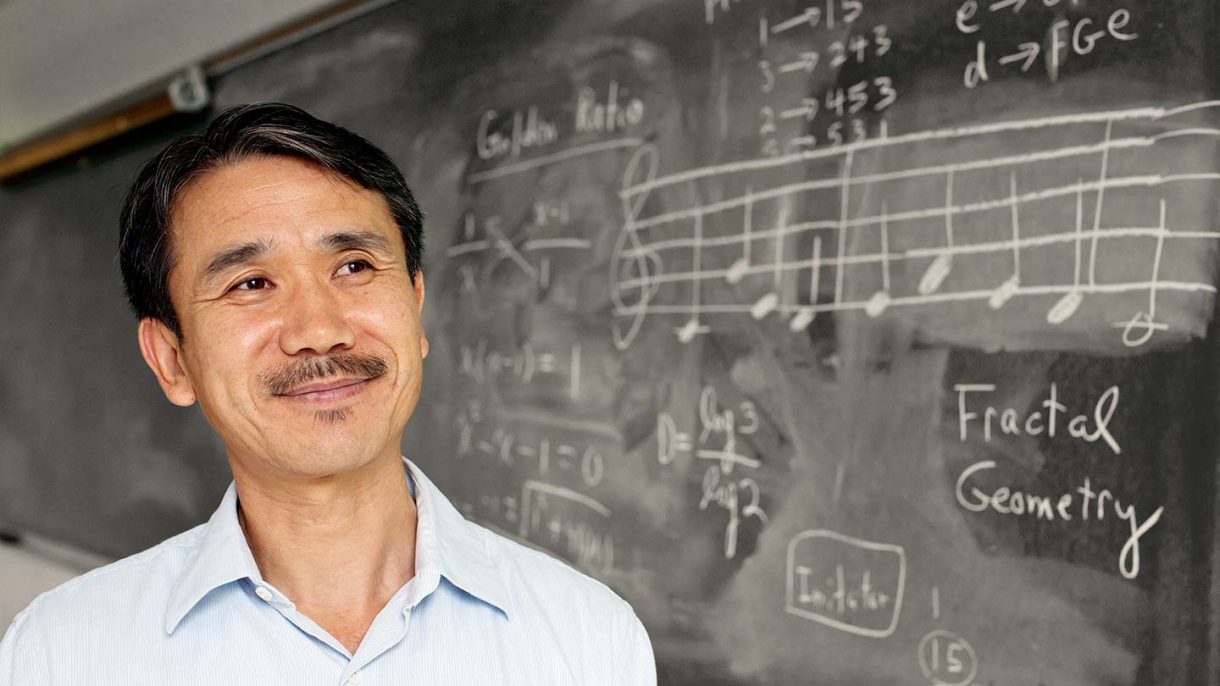
Meet Our Faculty: Dr. Duk Lee
Associate Professor of Mathematics
Originally published in Winter 2011
There is a certain ease about the way Asbury University Associate Professor of Mathematics Dr. Duk Lee sits on a stool and strums his classical guitar. It’s similar to the gentle manner and ease in which he communicates with his students and the ease in which he progresses through mathematical equations or fragmented geometrical shapes.
Based on his personal studies and the topic of papers and talks he’s presented, it’s no surprise that this mathematics professor relates easily to music and musical theory.
In a 2011 presentation provided to colleagues by Lee — who was chosen chair-elect of the Kentucky Chapter of the Mathematical Association of America in 2011 — he spoke about the mathematical study of music as a very ancient idea.
“Dating back to ancient Greece, Pythagoreans expressed musical intervals as numeric proportions,” Lee said. “Music and mathematics use different languages and deserve separate-independent places, but there are undeniable connections between them. Later under Plato’s influence, music was even understood as mathematical practice and application. However, this close relationship between these two disciplines seems forgotten or refused by many, including modern musicians and mathematicians.”
Recently, as Mandelbrot’s fractal geometry and its self-similarity concepts evolved — and, hence, influenced science, nature and arts — Lee says musicians also become interested in analyzing musical compositions in a new way, and they saw new languages from fractals in music.
“Beautiful and fascinating arts are created by fractal ideas, and people ponder if the beauty they find in art works, both visual or musical, has anything to do with the so-called “self-similarity,’” Lee said.
Mathematical procedures pertaining to fractal geometry construction have been implemented in making music by many, but some “fractal music” sounds — though interesting — are generally considered somewhat strange. This encourages the belief that creating music just with mathematics is not sufficient, and leads to an interdisciplinary project combining some components of mathematics, music theory, creative writing and technology. All of this is to create good sounding music that has a message.
To move in that direction, Lee says there must be an understanding of self-similarity in fractal geometry. A self-similar object is one that is exactly or approximately similar to a part of itself.
“Roughly speaking, when we know what the whole thing looks like just by observing a small portion of it, we say it has a self-similarity,” Lee said. “For example, a tree has a self-similarity. It could be created from a single vertical branch by an iteration process of attaching three small branches left, right, and top (see the visual example to the right). We could apply this iteration process in creating a sequence of musical notes, also.”
One example of this iteration process from Lee:
“To make a song in the key of C major or A minor — without any accidentals — we need a starting set of elements and rules for generating more elements. Say we start with a set of two notes, CE, and the rules are that the C note turns to three notes CGE, G to two notes EC, E to FE, and F to GC. The starting set and rules are purely random. For simplicity, assume each note is a quarter note. On the first iteration, CE becomes CGEFE. On the second iteration, CGEFE becomes CGEECFEGCFE. On the third iteration, CGEECFEGCFE becomes CGEECFEFECGEGCFEECCGEGCFE.”
If one iterates that way for infinitely many times, a fractal sequence of notes would be created and that would be “fractal music” with a self-similarity. “Now poets in creative writing class can come in and add a title and lyrics and a real song is born,” Lee said.
With fractals, lyrics and music technology such as Logic Studio, the logical next step is recording, and this interdisciplinary project was actually accomplished during this past summer of Kentucky Governor’s Scholars Program. Students in classes of modes of mathematical thinking, music and creative writing worked closely together.
“All of the high-school students were absolutely amazed by the beautiful music that was being created right before their eyes,” Lee said. “But the greatest outcome of them all is the realization that seemingly very different disciplines such as math, music and writing were able to collaborate for one common goal, making a fascinating piece of art.”
As published in Asbury University’s “Viaticum,” Vol. 1.